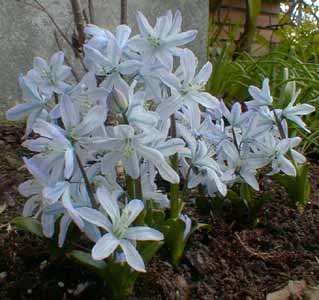
Van Tubergen's
White Squill
"So fair, so sweet, withal so sensitive,
Would that the little Flowers were born to live,
Conscious of half the pleasure which they give."
-William Wordsworth
(1770-1850)
(1770-1850)
'Tubergeniana' Early Scilla, or White Squill, has the Latin name Scilla mischtschenkoana, but is most commonly distributed as S. tubergeniana, as though that were its species name.
It is not a cultivar, but is a wildflower of Iran & southern Russia. 'Tubergeniana' is nevertheless a popular nickname, to make up for an unpronounceable Latin name. The nickname is after the Dutch bulb company Van Tubergen, which introduced this species to western gardens in 1936.
The sharp fat little leaves are only an inch or at most two inches tall when the blooms appear. The blooms can rise upward to four inches, in compact bunches of scilla flowers, but sometimes the flowers are on such short stems the blooms appear like little remnant patches of snow directly on the ground. Whether an inch tall or four inches, they are so little they are easily lost in the landscape without careful planning for their late-winter appearance.
It is charming to realize that the plant's stature should be the smallest of scillas, but the individual blooms in the cluster are surprisingly enough among the largest for scillas. In color & general appearance these blooms greatly resemble Puschkinia, but each bloom is bigger.
It blooms as early as late January & certainly (in our zone) before mid-February, lasting a while into March. They bloom ahead of all other scillas, showing themselves before snowdrops, & at the same time as our earliest snow crocuses, & the last of the winter cyclamens.
The flowers are white with a blue stripe down the midrib of every petal, with yellow stamins. These blooms have a pleasant odor that reminds me of brand new plastic baby toys, adding a hint of fruitiness.
On some specimens, the whole of each petal has a faint luminous lilac sheen, or is blue-white like polar ice. At other times they are as white as porcelain, apart from the blue midrib. I'm uncertain if these are distinct strains of faintest blue & purest white, or if that white to bluish-white range is dependant only on growing conditions.
The bulbs can be planted in more shade than is true for most bulbs, though not quite so much shade as other scillas thrive under. Bright shade or partial shade is best, or under deciduous trees to let in the required light when the scillas are ready to flower late in winter. Summer droughtiness after die-back is good for them, but while leafed & in flower they should never be entirely dry.
Because they are so short they need to be placed where taller plants will not hide them, & where their odor can be appreciated. They look best in largish drifts. They can be planted at the edge of grass or even partly into lawns, & are ideal for rockeries so long as the rock-garden isn't too dry in spring. Ours are right between the foot of a Peegee Hydrangea, & a garden walkway, under eaves.
They can be grown all the way down to USDA zone 3, & even into zone 2 if winter-protected by a heavy mulch. Above zone 6 it needs more protection from heat, but can adapt to zones 7 through 9 with reasonable sureness.